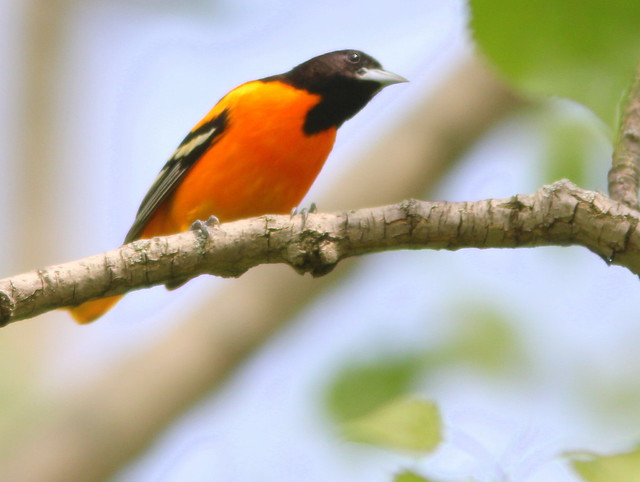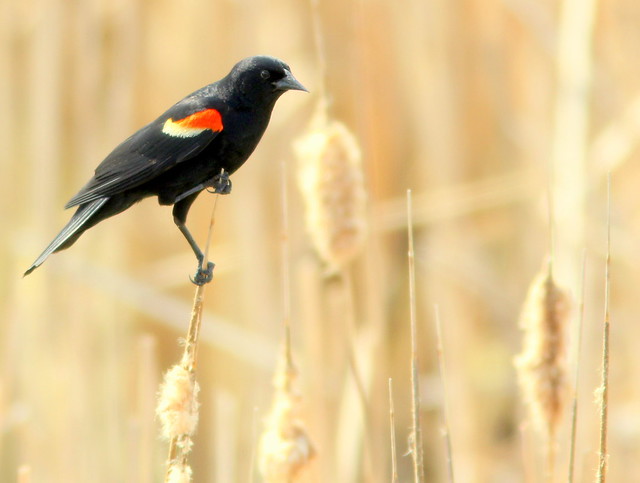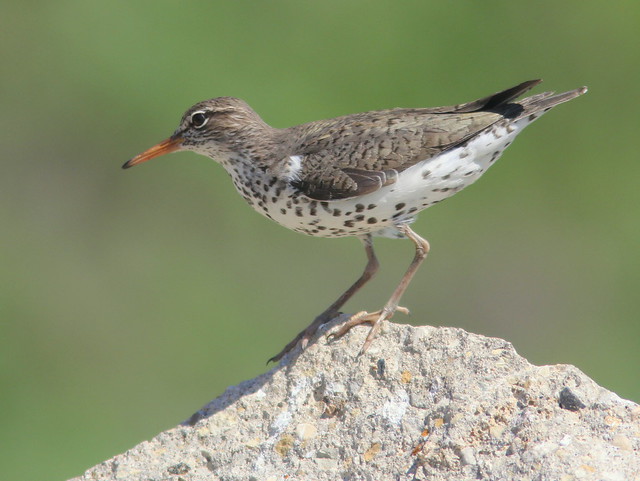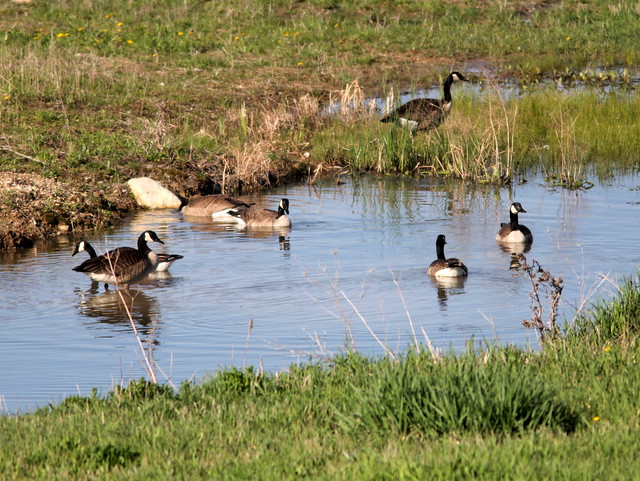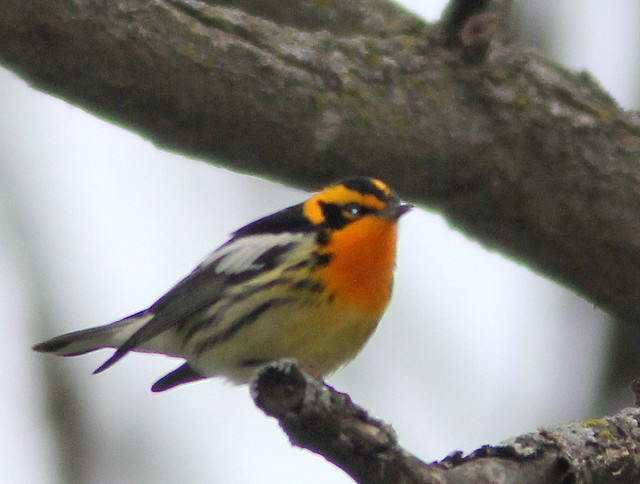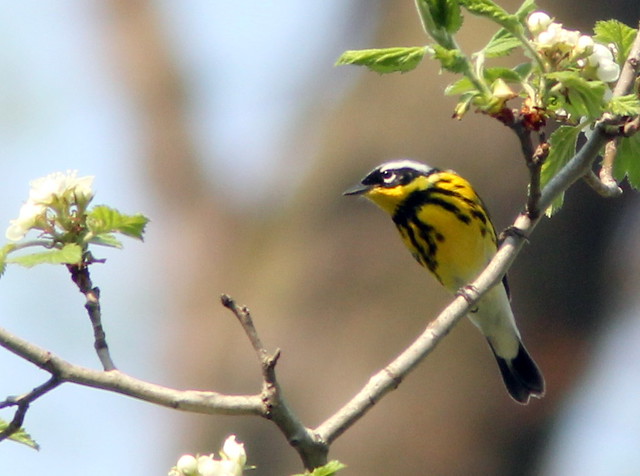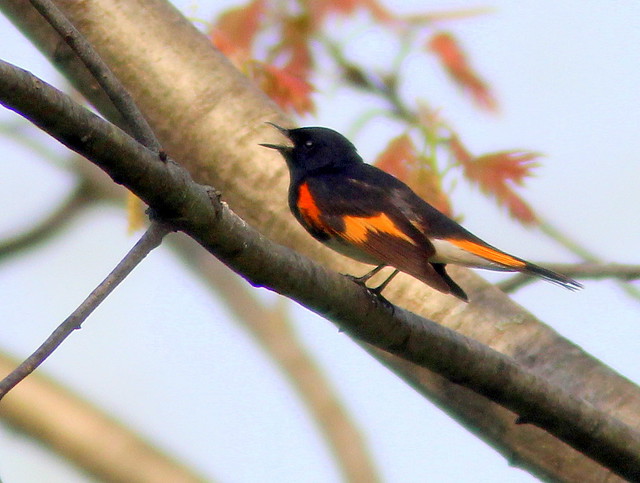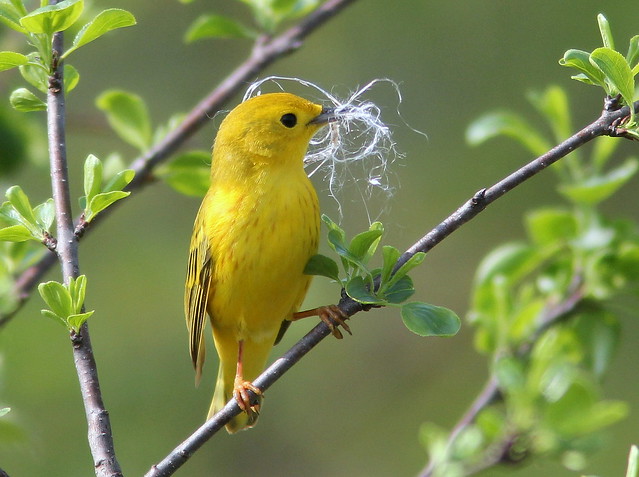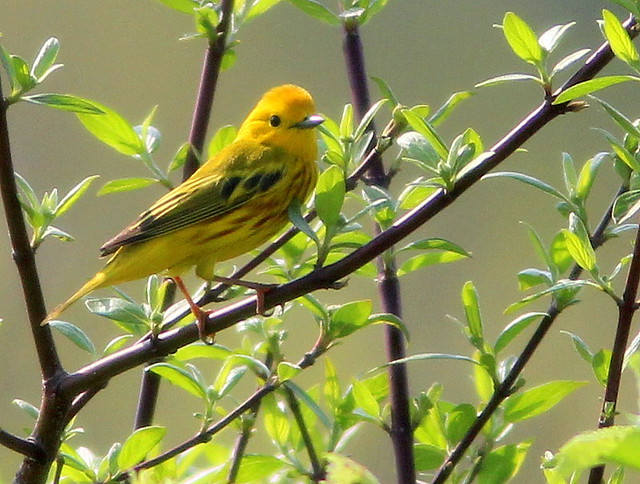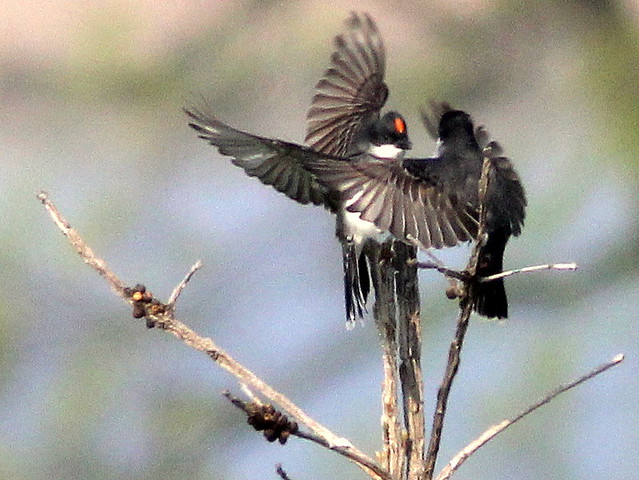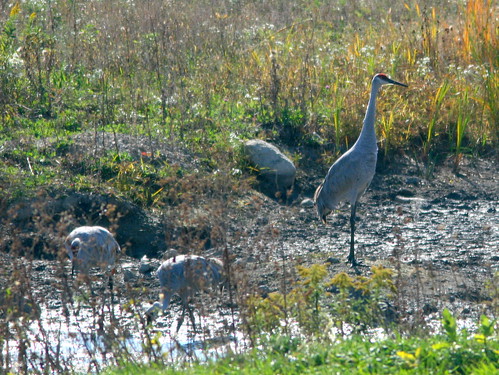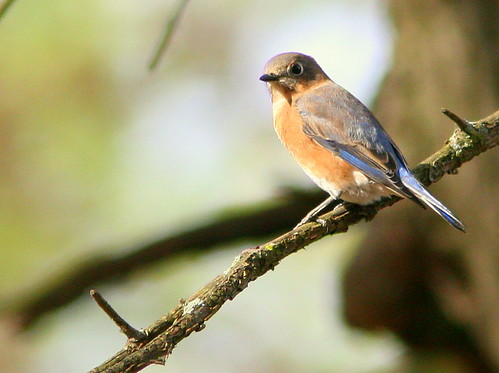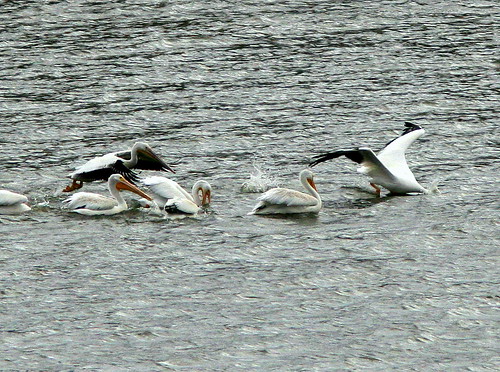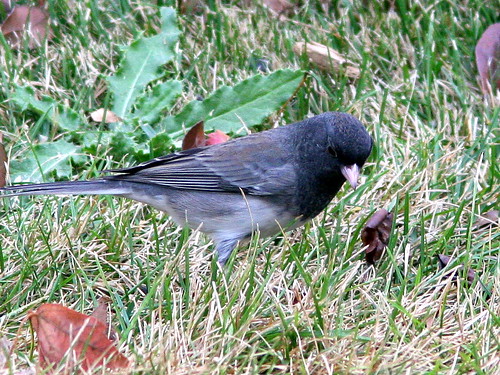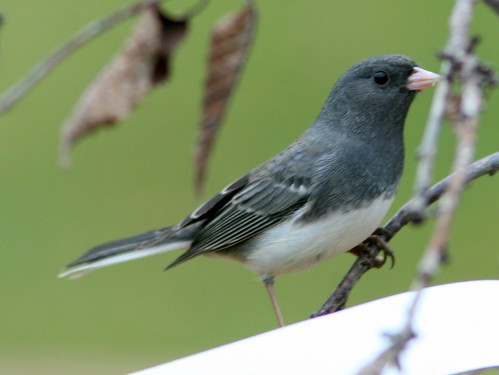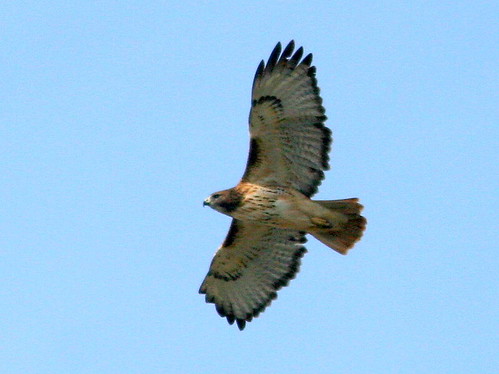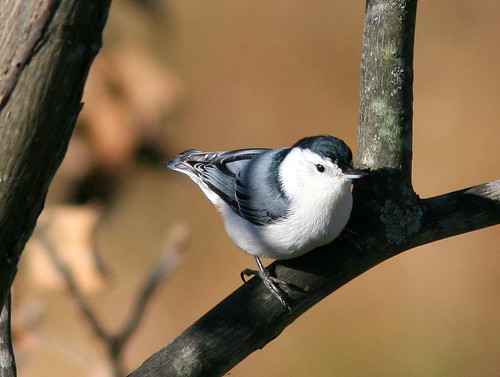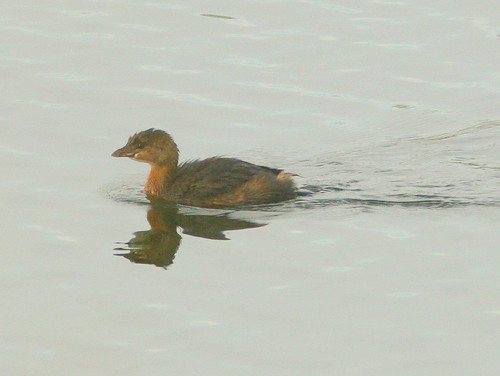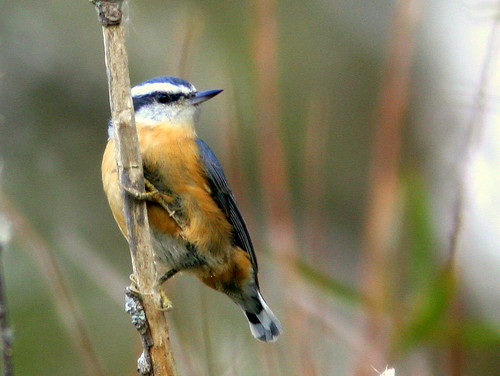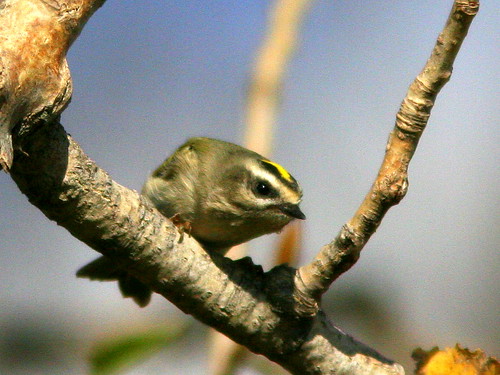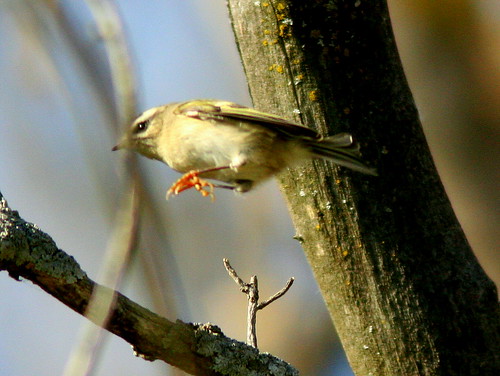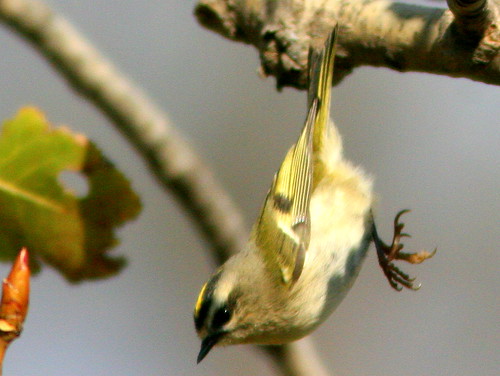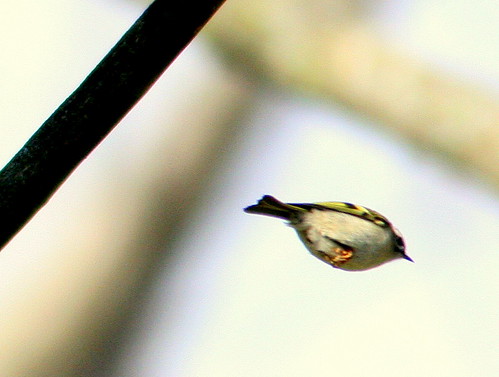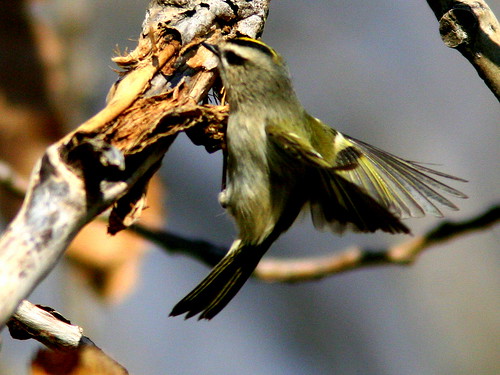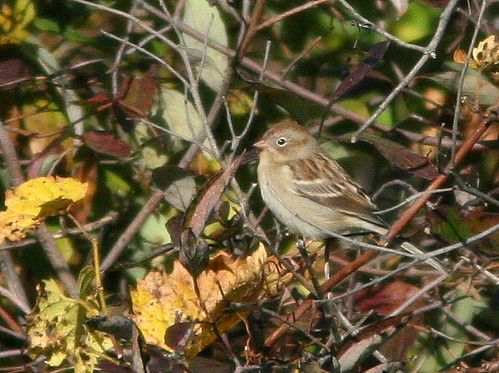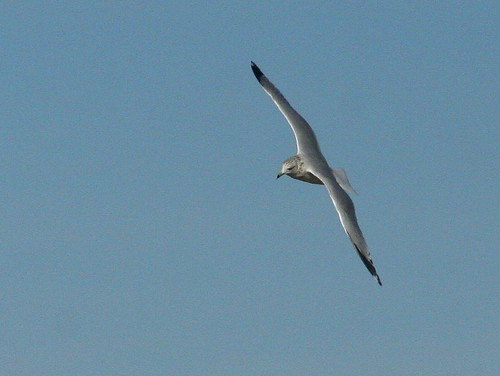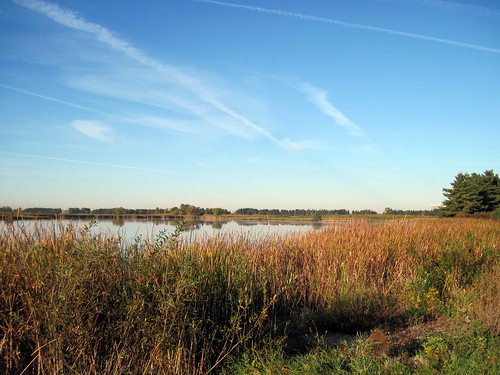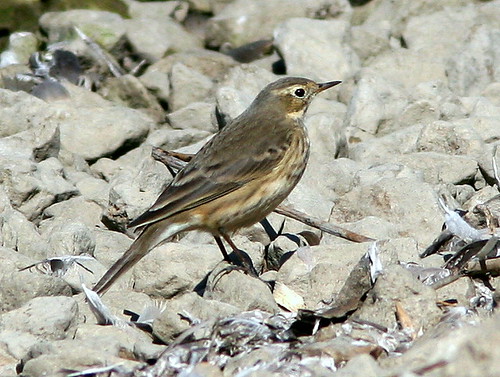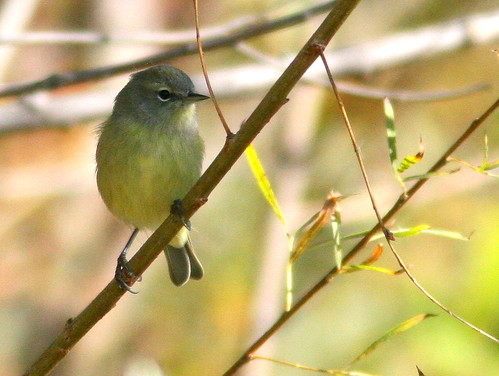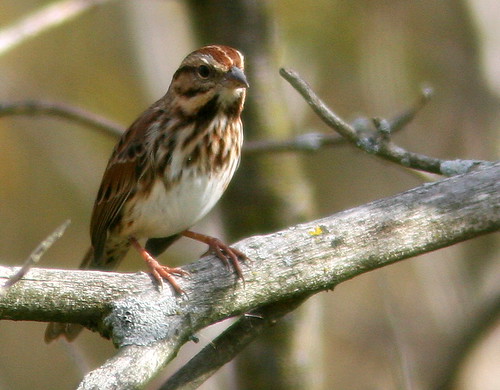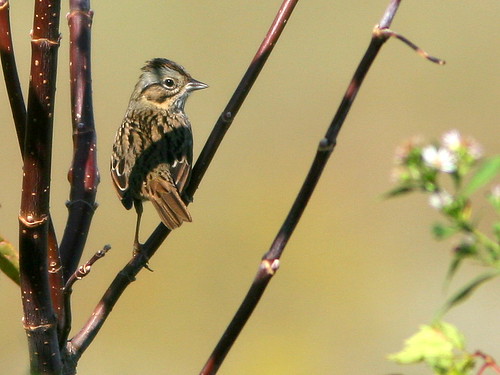Birding and wildlife photography, as spectator sports, are usually not considered very hazardous activities. Oh, I’ve stepped on yellow jacket tunnels, bumped my head against hornet nests, stood on fire ant hills, suffered itchy poison ivy rash and chigger bites, tripped over old barbed wire fences and battled deer flies and mosquitoes, but… I’m getting ahead of myself, so let’s start at the beginning.
Back in Illinois, illness had curtailed my outdoors activities and caused me to miss the height of warbler migration. I did get out one morning for a brief walk in Jones Meadow Park near our home.
A Warbling Vireo was in full song…
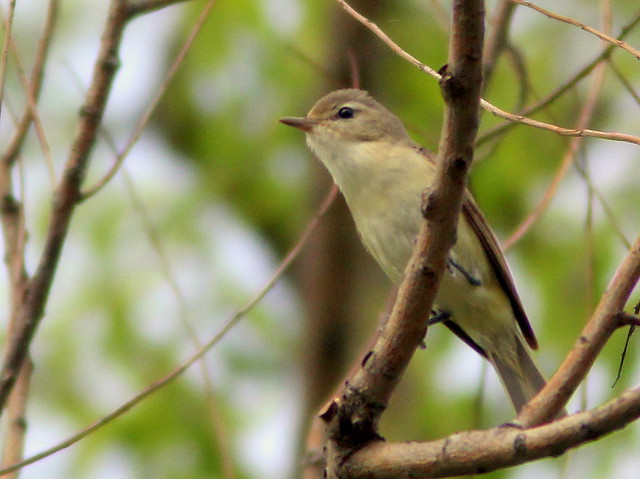
…a tiny House Wren posed nicely…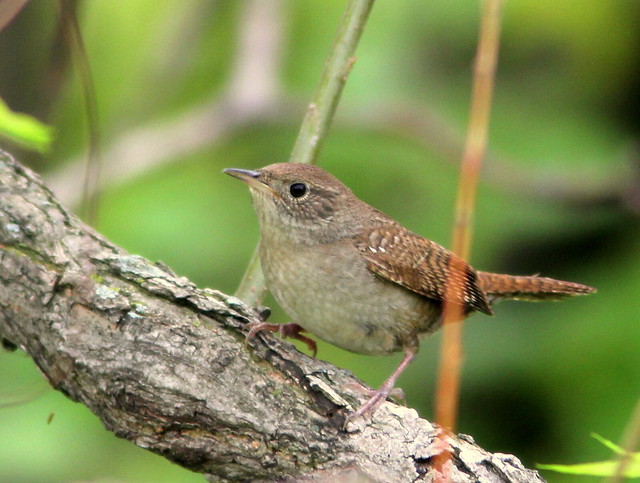
…and a brilliant male Baltimore Oriole peered down from atop a Cottonwood:
Black birds make challenging subjects because the camera receives conflicting signals about exposure, but this side-lit Red-winged Blackbird stood out nicely against a background of over-exposed and out-of-focus cattails:
The camera also treated his somber mate rather nicely:
Driving back to the condo, I noticed that a Horned Lark was singing on a pile of rocks in the vacant lot adjacent to our building. The next morning, our last full day in Illinois, I drove to a vantage point that was only about 20 feet from that spot. The sun was bright and already rather high. I had attached my Better Beamer Flash X-Tender to my flash unit, thinking that I might need some fill flash because of the harsh shadows. As I approached the rock pile, a Horned Lark flew off. I waited a while, hoping it would return. Meanwhile, a Spotted Sandpiper was singing in the distance. It moved from one pile of gravel to the next. Suddenly it was right in front of me.
The Spotted Sandpiper gave me a nice side view, in perfect light:
It flew to another rock pile, where the front door of our condo, out of focus in the distance, provided a halo effect for its image (no need for Photoshop):
A Horned Lark then appeared on the road some distance away, in harsh sunlight: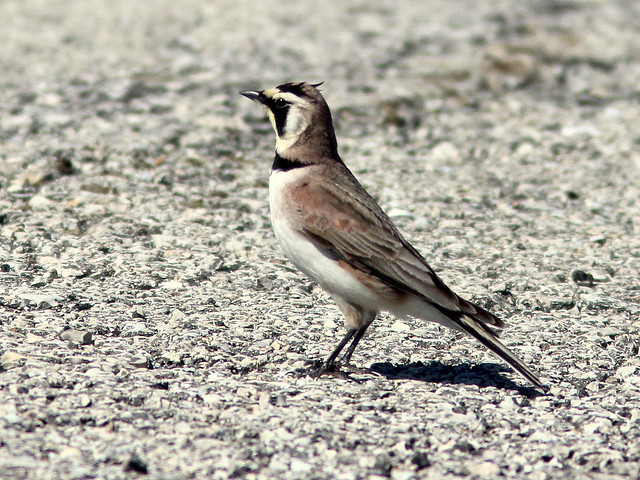
Finally, an Eastern Meadowlark closed the show by singing from a post on the other side of the road. There was no need for fill flash, as back-lighting actually enhanced its color and texture: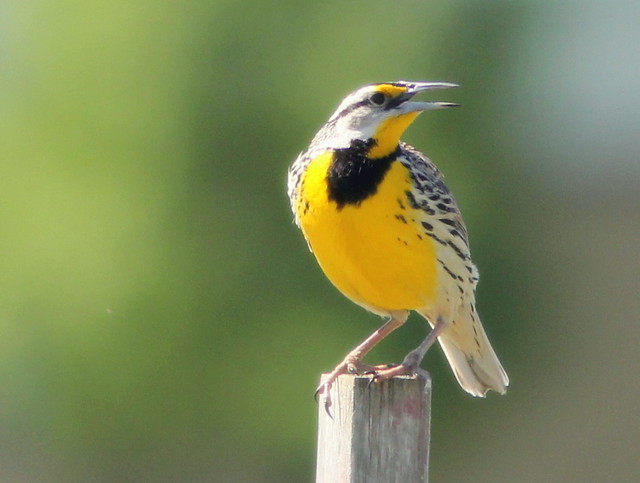
Oh– and while I was photographing the sandpiper I almost had a serious accident. My phone rang with a call from our second-oldest grandson. He wanted to tell me about his baseball game and how he was injured when a hitter deliberately ran into him after being forced out at first base. I placed the camera on the passenger seat, and proceeded with our conversation. Suddenly I smelled smoke– like burning rubber. I looked around outside, thinking someone was burning tires. Then I realized that the smoke was coming from inside the car! The full sun was shining on the Fresnel lens of my Better Beamer, and the focal point of the lens concentrated the beam on the rubber pad on the camera strap. Luckily, I moved the unit into the shade before flames erupted.
My camera gear gives me the right compromise between lens size and weight (about 6 pounds), as I can easily carry it into the field and generally use it hand-held, without need for a tripod (except for videos): Canon EOS 60D 18 MP Digital SLR Camera with Canon EF 300mm f/4L IS USM Telephoto Lens with Canon EF 1.4X II Extender (420 mm f/5.6 lens system), and Canon Speedlite 580 EX II flash unit.
The offending Better Beamer Flash X-Tender is shown attached to the flash unit:
For more information about the dangers of Fresnel lenses, visit this link.
Fresnel lenses can be dangerous!
You should always treat a Fresnel lens with respect - as if it were an open flame!
If you consider that a small magnifying glass and direct sunlight can burn paper, it is not surprising that even a rather small Fresnel lens (20×28cm) can concentrate enough sunlight to instantly incinerate paper, burn wood and even vitrify some types of sand! When experimenting with a Fresnel lens, always treat it as if it were an open flame - and children should not play with it unless they are supervised! Even the briefest exposure of skin at the focal point of a Fresnel lens exposed to full sunlight can instantly cause severe burns!
If you store a Fresnel lens, you should always do so in such a way that it can never be exposed to sunlight! If, for example, you left a Fresnel lens in a location where, at some time of day, it was exposed to the sun and there was something on the other side of the lens at even approximately the focal length of that lens, it could be burned when the sun angle was appropriate.
If you mount a Fresnel lens in a frame, make sure that it is stored such that it can never be exposed to sunlight. If you are transporting such a lens, always carry it in a covered box or drape it with cloth to prevent it from being exposed to the full and concentrated energy of the sun!
In other words, an improperly-treated Fresnel lens can not only burn you, but it can case severe property damage!
We were greeted by unusually warm weather upon our arrival in northeastern Illinois. We got out early most mornings and found that, indeed, we had caught up with the spring migrants that are now mostly gone from Florida. This is actually an inaccurate statement, as most of the birds we are seeing up here have almost certainly followed the Mississippi Flyway, an entirely different migration route than the Atlantic Flyway that runs through peninsular Florida up into the northeastern states and provinces. However, individual species, such as the Palm Warbler, may follow unique circular patterns of migration.
The dull “Western” race of Palm Warbler is very common all winter in Florida, and we rarely see the bright “Yellow” eastern form such as this one I photographed this past week here in Illinois:
The Western race of the Palm Warbler is not seen along the East coast in spring, but is found farther inland during that season. In the fall, these birds depart from breeding grounds in northwest Canada and move almost due east until turning southward along the Atlantic Coast, with much of the population spending the winter in Florida. In spring, they fly more directly northwest to their summer homes. The eastern Yellow Palm Warblers winter more to the west, from northern Florida into east Texas, and their spring migration path actually crosses that of the northbound western race. This is vividly illustrated on this animated eBird Occurrence Map
Spring migration can be full of surprises. Our Illinois front “yard” is actually a disturbed plot that was abandoned by the developer when the company went bankrupt. It contains a small “fluddle” (a common name that local birders give to low spots in the prairie that fill with water from snow-melt and spring rains):
One morning I happened to look out our second-story bedroom window and was amazed to see the white head of a “Blue” morph Snow Goose that was foraging with a small flock of Canada Geese. Its behavior raised an interesting question.
I took this and the above photo through the window pane: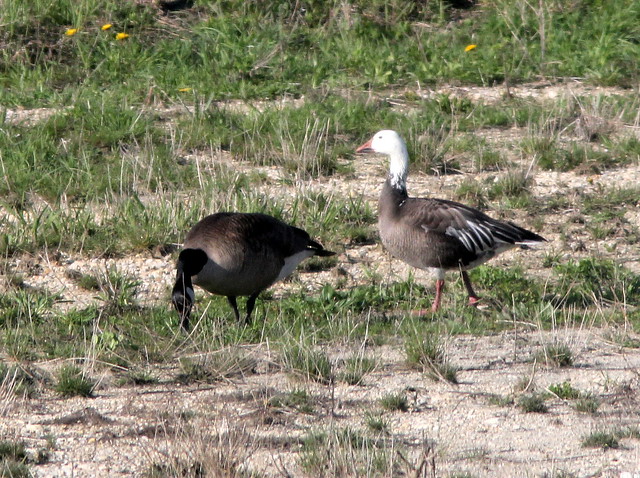
The Snow Goose tended to associate with one of the Canada geese, and the two spent much of their time apart from the rest of the flock. A couple of weeks ago, a neighbor who lives on the lake at nearby Jones Meadow Park sent me photos of a similar Snow Goose that also was associated with one Canada Goose, suggesting that they may be bonded. The far northern edge of the breeding range of Canada geese overlaps with that of the Snow Goose. The latter species is known for “dumping” its eggs in neighboring nests. Is it possible that this Canada Goose raised this particular bird? I could find no specific references to this on the Internet.
Warblers are the main attraction in the spring. Serendipitously, a Nashville Warbler flew up just as I depressed the shutter. Believing I had captured only an empty branch, imagine my surprise when I viewed my photo on the computer screen and saw what looks like a photo-shopped image of the flying bird “perched on air”:
Atypically, this male Common Yellowthroat occupied an open perch from which to sing:
It was great to see Yellow-rumped Warblers in bright spring plumage: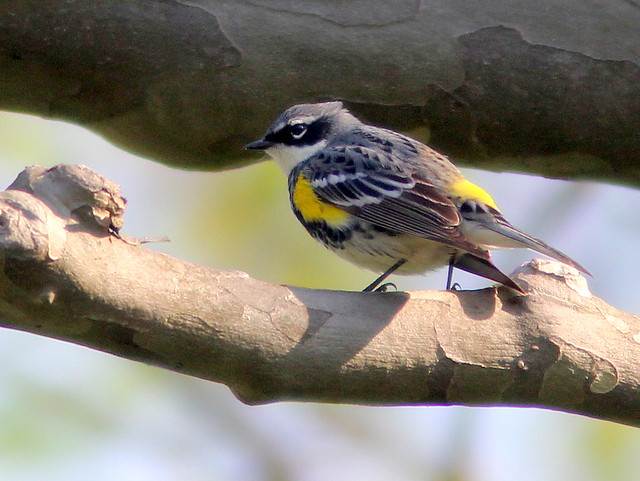
Although this is not a very sharp image, it is my first shot of a Blackburnian Warbler:
This Black-throated Green Warbler had just taken a bath:
A Magnolia Warbler posed nicely on a flowering tree:
In Florida, the warblers are usually silent, but this American Redstart at Aurora West Forest Preserve near our Illinois home was singing vigorously:
A female Yellow Warbler was busy gathering nest materials:
The male Yellow Warbler watched from a nearby perch:
Eastern Kingbirds had just migrated into Nelson Lake/Dick Young Marsh Forest Preserve, one of our favorite birding patches. Three kingbirds were gathered on a small tree in the prairie. Two were fighting while the third looked on. I presume they were two rival males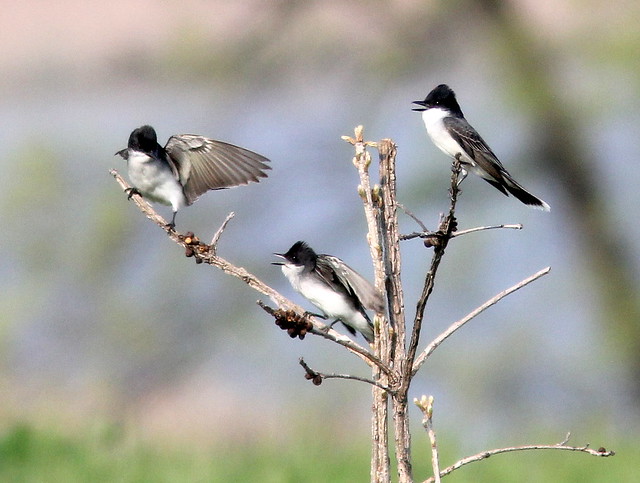
I have rarely seen an Eastern Kingbird display its usually-hidden red crest stripe, and this was my first opportunity to photograph this feature:
This has to be one of my favorite Northern Cardinal photos. The bird posed nicely in front of a tree trunk, thus cutting out the back light, and it also was a fine specimen with a clean bill:
New “yard birds” for our summer home in northeastern Illinois, this family group of three Sandhill Cranes showed up at a flooddle in our front yard, which is actually a vacant lot. They looked so white that I thought for a moment they were Whooping Cranes. I took this photo through the upstairs window of our condo, hence the poor quality:
During a fun-filled but rainy weekend at Starved Rock, in Utica Illinois, we got in a little birding between the raindrops while our granddaughters played all day in the huge indoor water park at Grizzly Jack’s resort.
There were several flocks of Eastern Bluebirds in old trees on the south bank of the Illinois River:
We welcomed the sight of bluebirds, which have already abandoned our area of the state, only about 50 miles to the north:
Visible from the north side of the river, a flock of American White Pelicans fished cooperatively. They moved in a tight formation:
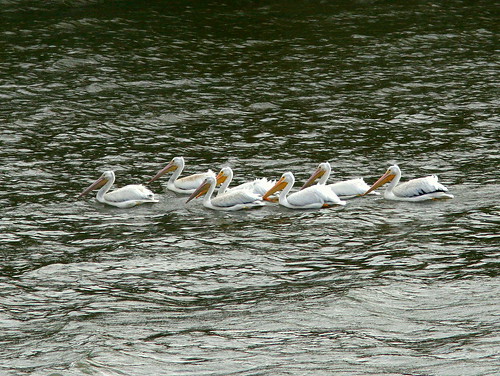
Then they flew a short distance to a spot where bait fish were jumping:
Finally, together, they herded a school of fish and feasted:
We have enjoyed beautiful weather this fall, but the past week our birding was curtailed by one of the worst wind storms ever to hit the Midwest. While we were holed up by the wind and cold I spent time observing the bird feeder in our daughter’s back yard, in Batavia. Dark-eyed Juncos have arrived in large numbers.
This junco has a very dark, almost black hood, a color variation more common in the Canadian Rockies:
Here is a male “Slate-colored” Junco with more typical plumage. Note its pale pink bill:
The adult female “Slate-colored” shows more brown on her back and sides:
A Black-capped Chickadee brightens a dreary day: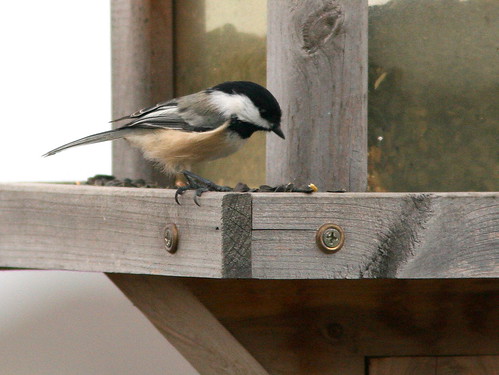
Of course, there were House Sparrows, a species that we do not have in our South Florida neighborhood:
We had time to notice the blue eyelids of a Mourning Dove, framed by the wrought iron fence…
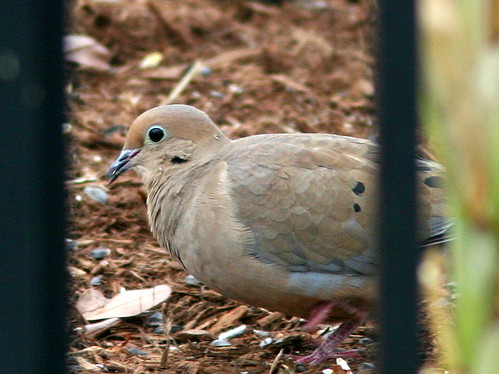
…and enjoy the sight of a soaring Red-tailed Hawk:
As soon as the weather broke, we headed over to Nelson Lake/Dick Young Forest Preserve to see whether the cold front had brought in any unusual birds.
A Northern Cardinal is anything but unusual, but who can resist its charm?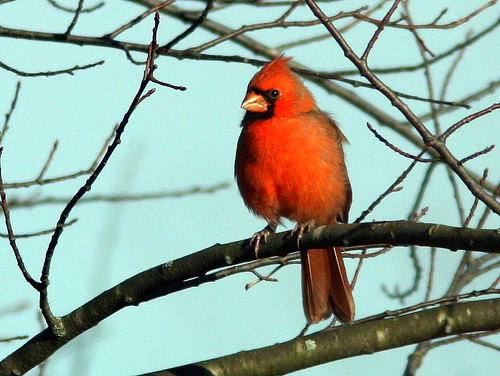
The morning sun reflects off the white breast of the (what else?) White-breasted Nuthatch:
A lucky shot catches this Fox Sparrow in a Kamikaze dive: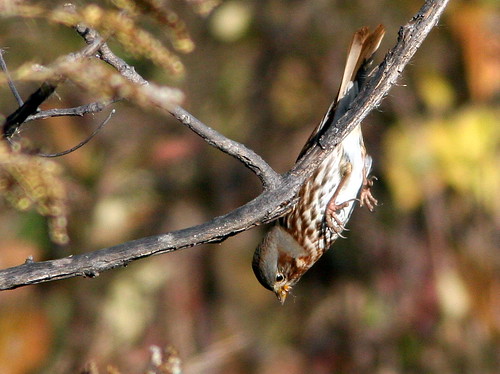
We then took our grandchildren to the playground at nearby Jones Meadow Park in North Aurora. After I had checked out the retention pond, our 6 year old granddaughter called my attention to a “Greed” diving among the Canada Geese.
Sure enough, she had spotted a Pied-billed Grebe that I had overlooked:
While Mary Lou supervised the girls, I stole off a short way down the path. As I was looking at a Hermit Thrush, a Lincoln’s Sparrow popped up in a small willow not more than 15 feet away. This species breeds to the north, and passes through Illinois to winter in the southern states.
The Lincoln’s Sparrow was in perfect light, and it posed for nearly a minute (click on photo for additional views):
The Red-breasted Nuthatch mostly nests just north of the Chicago area, but spends the winter here, joining its larger White-breasted cousin. Both birds have slightly upturned bills, an adaptation for foraging upside down on tree trunks.
Red-breasted Nuthatch:
The locally-breeding White-breasted Nuthatch strikes a classic head-down pose:
The two kinglet species are also migrating through northern Illinois While the Ruby-crowned Kinglets will continue on south, the Golden-crowned species will stay for the winter.
The Ruby-crowned Kinglet is usually reluctant to flaunt the red feathers to which he owes his name. One might see a hundred of these active little birds before getting a glimpse of their ruby crown. I have seen it most often in the spring, in encounters between two singing males. At Nelson Lake/Dick Young Kane County Forest Preserve, I witnessed what appeared to be an aggressive exchange between two Ruby-crowns, during which one of the birds repeatedly, but very briefly, erected the red feathers atop its head.
The active little bird moved too fast for my camera, and this blurry photo was the only one to exhibit the ruby crown:
This spring, I did catch one in full display: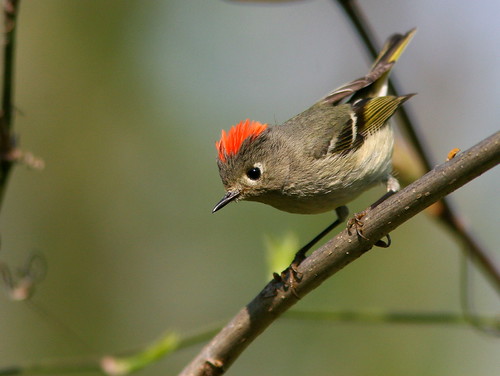
Last week, Mary Lou and I encountered an unusually large group of Golden-crowned Kinglets at Jones Meadow Park, a small oasis of woodlands and wetlands in suburban Kane County, Illinois. On the return leg of our walk, we stopped by a Cottonwood grove. Golden leaves littered the ground underneath the trees, which were now almost entirely bare.
Golden-crowned Kinglet:
Initially we found no birds among the stark branches, back-lit by a cloudy morning sky. Just as we were about to stop looking, the first contingent of kinglets appeared out of nowhere. They worked their way across the grove, streaming from left to right. In groups of 5 or 6, there may have been as many as two dozen birds, unaccompanied by the (usually) more common Ruby-crowned Kinglets. Since Cottonwoods shade out and self-prune their lower branches, most of the birds were up pretty high, but some flew into a few saplings near us along the trail, and they provided a great photo opportunity.
This kinglet seemed curious about my presence:
The birds were extremely active, so I caught them fluttering…
…taking big leaps…
…Olympic-class dives…
Their proximity allowed me to capture other aspects of their typical behavior, such as hover-gleaning:
We also re-visited Fermilab in DuPage County in hopes of finding Harris’s and Nelson’s Sparrows, but instead saw lots of Field Sparrows:
We saw a hardy Eastern Phoebe, which will soon be forced to depart as its supply of flying insects is depleted by the cold:
Fox Sparrows were singing:
In perfect light, a Ring-billed Gull made a dramatic pass over Lake Law:
We have been enjoying remarkably fair Autumn weather at our second home in northeast Illinois. In between the obligations and joys of sharing time with family and friends, there has been time for at least one birding excursion nearly every day.
One interesting venture last week was with Kane County Audubon Society, to the Fermi National Accelerator Laboratory (Fermilab ). Located in Batavia near Chicago, Illinois, this is a US Department of Energy national laboratory specializing in high-energy particle physics. Fermilab is very birder-friendly, and there is a great variety of natural habitat on their extensive grounds. The official Fermilab web site has an interactive map with links to the various birding “hot spots” within the 6800 acre facility. Peter Kasper updates a current list of bird sightings that is worth watching, as many rarities have appeared there over the years.
We gathered at the famous “Red Barn,” and walked the area known as Village Lakes:
Lake Law is near the start of the trail. It harbored lots of migrating Canada Geese, a pair of Pied-billed Grebes, and a few Green-winged Teal and American Coots:
Two American Pipits along the shore of Lake Law tolerated our close approach:
We had hopes of seeing Harris’s Sparrows, which have appeared in the Chicago area during the past couple of weeks and have been sighted at Fermilab many times in past years. Although I carried my camera on the walk, I put it to little use, something that often happens when I am hiking with a group. Alone, I am free to linger and look for the best shots, but this is hard to do when trying to keep up with other birders. For example, I got great binocular views of an Orange-crowned Warbler, but did not even think of my camera until it had flown into a thicket, the signal for the group to move on. I also failed to obtain photos of Fox Sparrows that lurked in the hedges.
Also in Batavia, but nearer to home, at Nelson Lake/Dick Young Forest Preserve, I did get a good shot of the normally reclusive Fox Sparrow that Mary Lou spotted for me: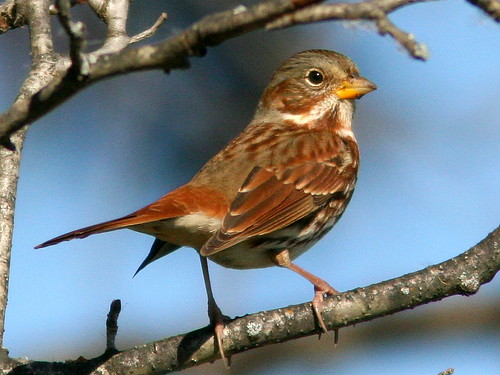
We also had better luck with Orange-crowned Warblers, finding them on three consecutive days at Nelson Lake and also this one at Jones Meadow Park in North Aurora, which was foraging with a single Ruby-crowned Kinglet in low vegetation. Note is characteristic broken eye-ring and yellow under the tail:
The Orange-crowned Warbler emerged into full light and plunged off its perch in pursuit of a green insect that looked like a Katydid:
Its free-fall ended with the successful capture of the insect:
Eastern Bluebirds had nested in Jones Meadow Park a couple of years ago, but none were there all summer until this past week, just about when we would expect this species to disappear on its southward migration:
We saw this bluebird at nearly the same location this past spring:
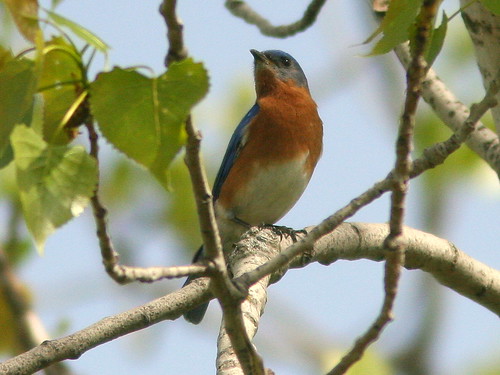
In contrast, a “snow bird,” an early arriving Dark-eyed Junco showed up on the same day. We have been seeing them for about a week, but this was the first I was able to photograph this fall:
White-throated Sparrows sang softly along the asphalt track at Jones Meadow. This is a tan-striped individual. Older field guides often identified these as immature or female birds, in contrast to the white-striped “adults,” but this color variation, usually also showing streaks on the breast, appears in adults of both sexes:
To illustrate the difference, here is a close-up of a white-striped bird that I photographed this past spring at nearby Lippold Park:
Song Sparrows also treated us to short bursts of song. This bird had a particularly reddish tinge to its plumage, initially making me think it was another Fox Sparrow. It reminded me of the southwestern subspecies that I often saw in New Mexico:
Nearby, another streaked sparrow, which I first thought to be a Song Sparrow with an unusually gray head, has the head pattern typical of Lincoln’s Sparrow, as Peter Kasper himself kindly pointed out:
The smaller Savannah Sparrow is shorter-tailed and often shows some yellow in front of its eyes:













